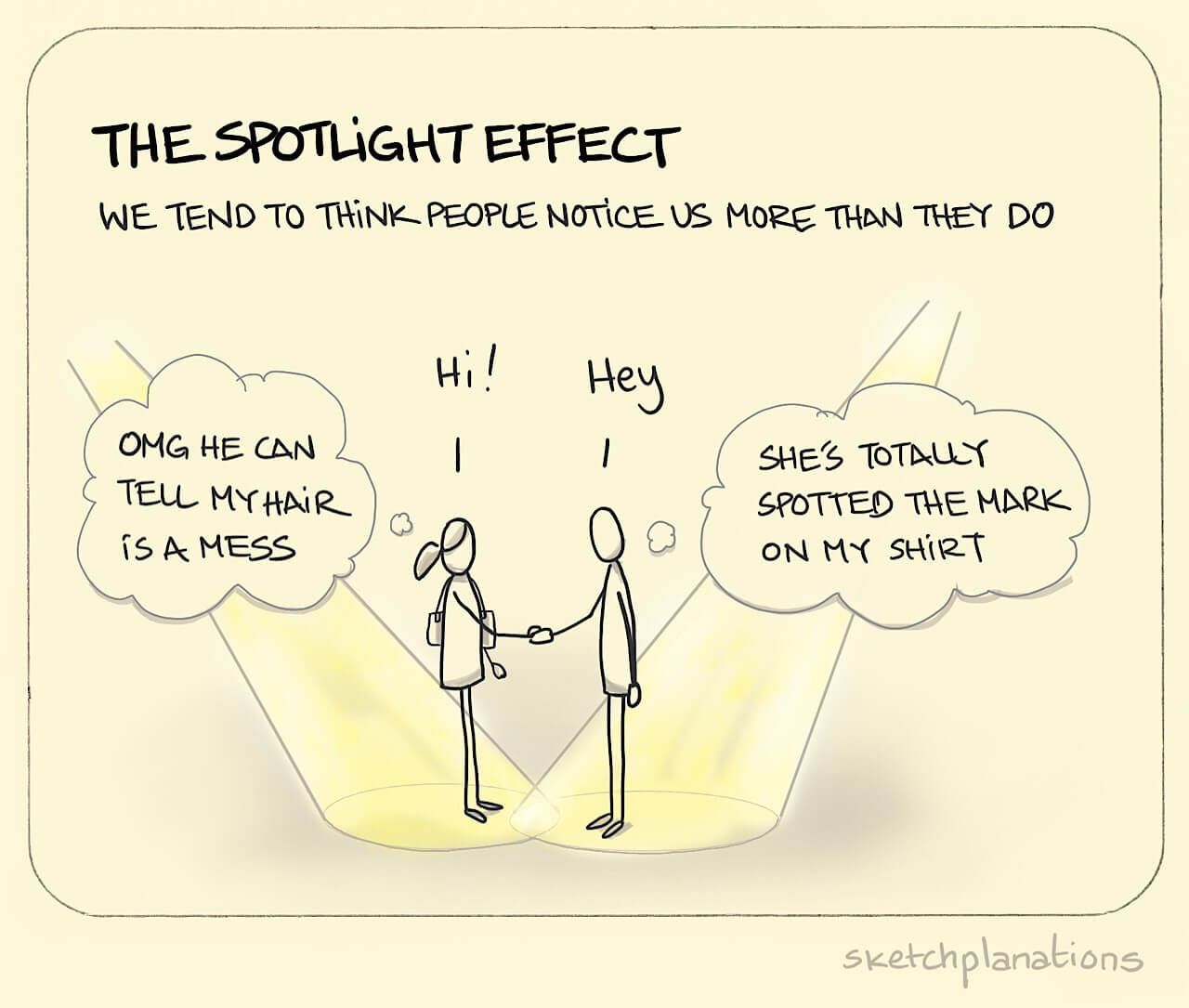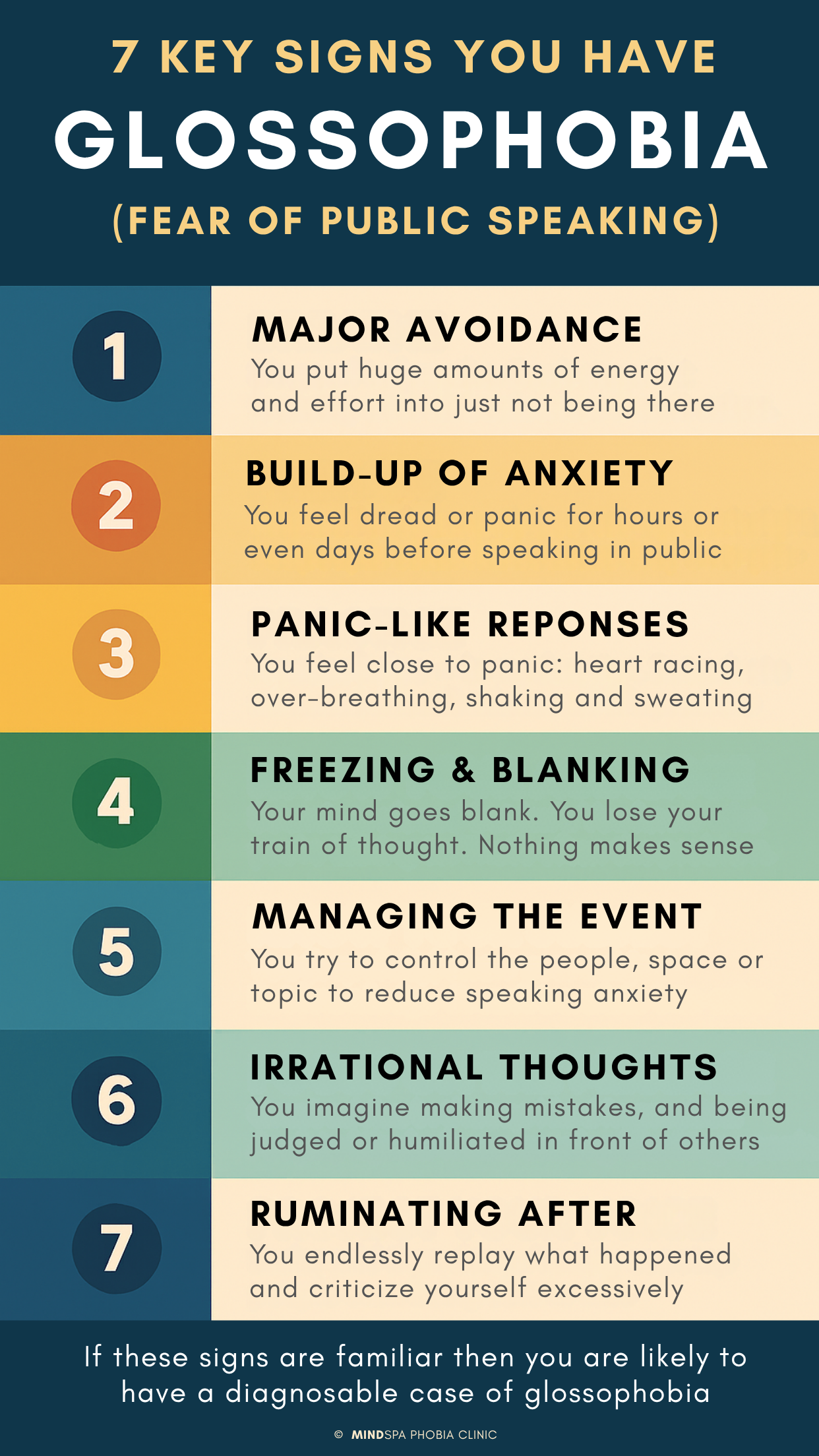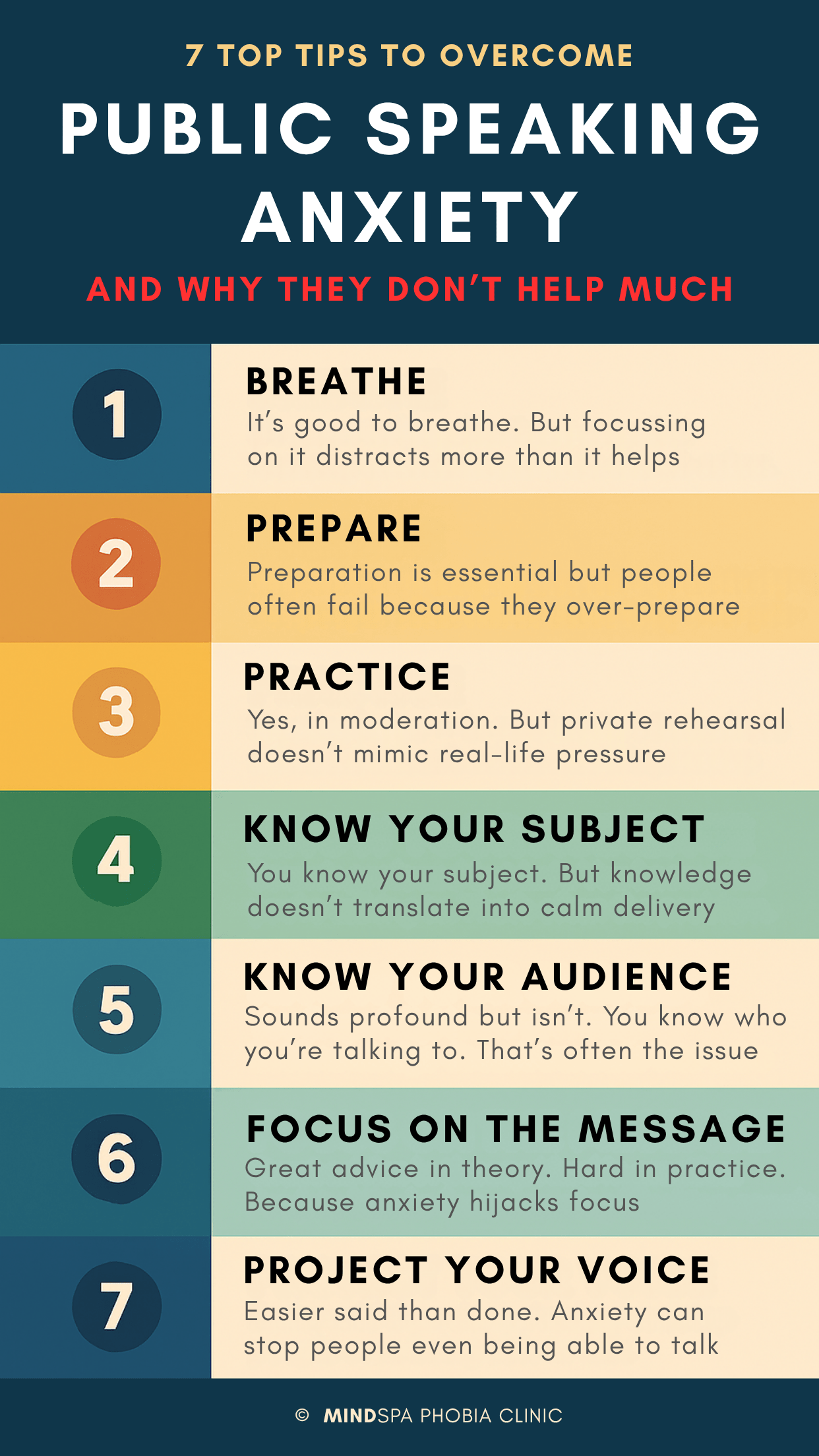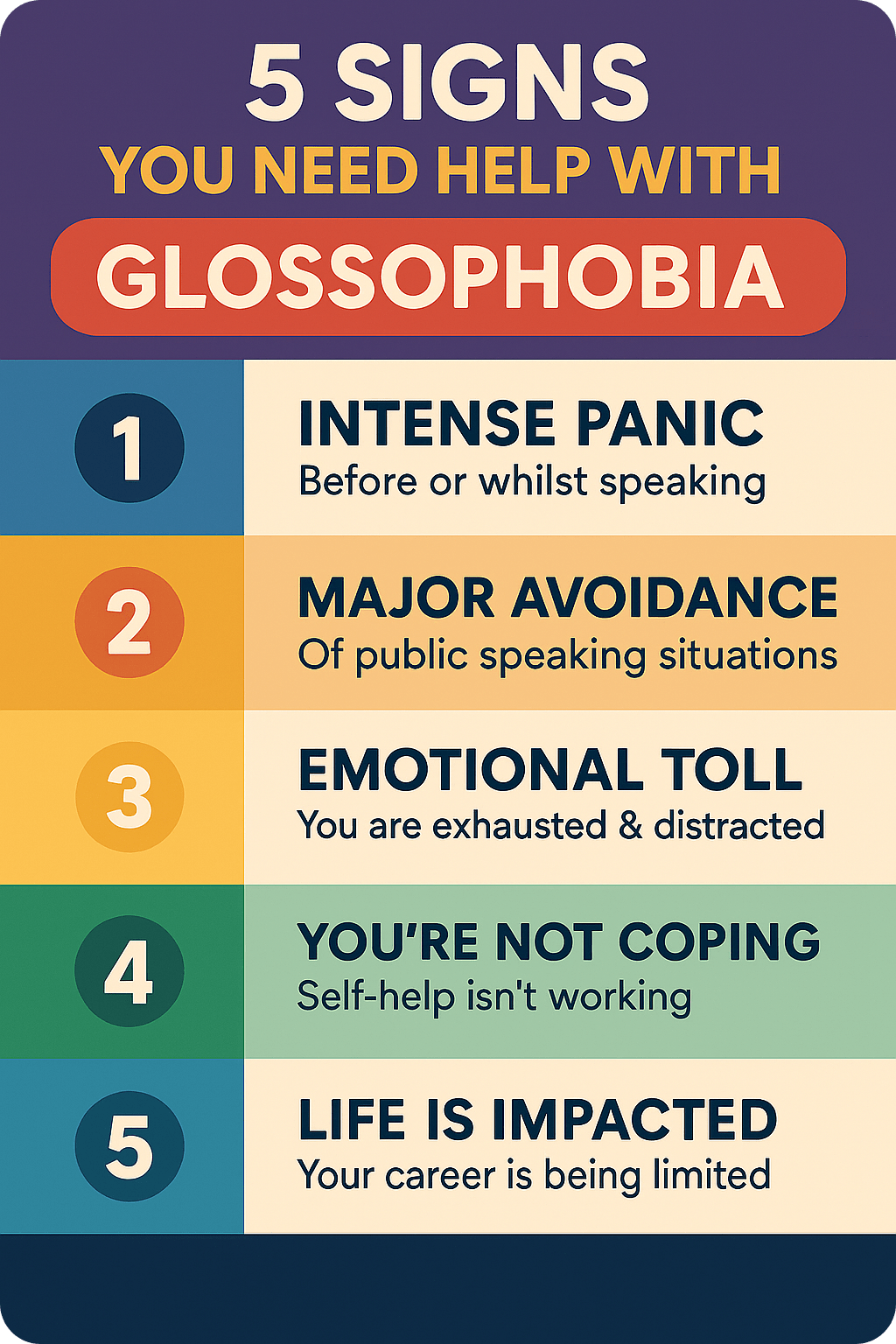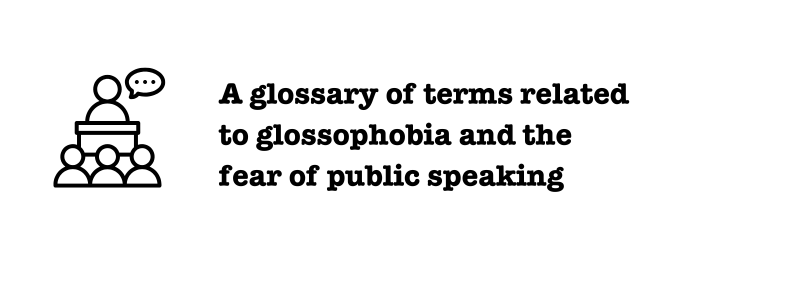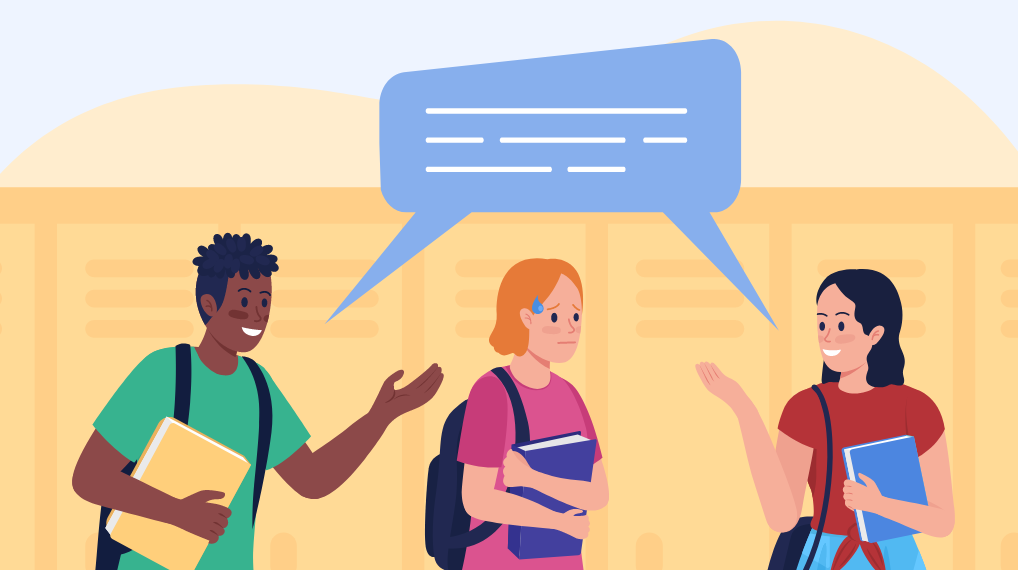The Spotlight Effect and Glossophobia
Shedding Light on Our Self-Consciousness
Imagine walking into a room wearing a Barry Manilow t-shirt. You immediately feel like everyone is staring, judging, and silently mocking your choice. In reality, hardly anyone notices. Those who do might not care—or might even like it.
This exaggerated sense of being observed is called the Spotlight Effect. It’s the belief that others are paying far more attention to us than they actually are. The Spotlight Effect is one of the key drivers of glossophobia (the fear of public speaking) and plays a major role in social anxiety.
What Is the Spotlight Effect?
The Spotlight Effect is a cognitive bias where people overestimate how much others notice and judge their appearance, behaviour, or mistakes. It creates the feeling that a spotlight is shining on us, making us seem more visible and vulnerable than we really are.
In reality, most people are far too preoccupied with their own thoughts to closely scrutinize others. Yet for someone with public speaking anxiety or social phobia, the Spotlight Effect can feel overwhelming—making everyday interactions stressful and amplifying the fear of being judged.
Everyday Examples of the Spotlight Effect
The Spotlight Effect can appear in many situations, such as:
- Public speaking: When giving a presentation or talking in a meeting, people imagine that everyone must be paying great attention to them and noticing any signs of their anxiety and discomfort, such as shaking, sweating or changes in their breathing or voice.
- Sports performance: Overestimating how much teammates notice or care about mistakes.
- Clothing choices: Feeling like everyone is judging a new outfit, when most people hardly notice.
- Social events: Imagining you are the centre of attention at a party, with others scrutinising every move.
- Embarrassing moments: Believing that tripping, spilling a drink, or mispronouncing a word is unforgettable for everyone around, when in fact most people quickly forget.
Research Behind the Spotlight Effect
There’s been a lot of research into the Spotlight Effect, but the most well-known study was by psychologists Thomas Gilovich and Kenneth Savitsky at Cornell University. They asked participants to don a highly embarrassing T-shirt (featuring Barry Manilow) and then estimate the percentage of people who would notice and remember what they were wearing. The participants overestimated this percentage, illustrating how we tend to exaggerate the extent to which others are scrutinizing our actions and appearance.
What Causes the Spotlight Effect?
Several psychological factors contribute to the Spotlight Effect:
Egocentric bias – We naturally see ourselves as the centre of events, assuming others do too. This can lead to misunderstandings, poor communication, and difficulties in interpersonal relationships or group decision-making situations.
The Illusion of Transparency - This is a cognitive bias where people overestimate the degree to which their personal thoughts, feelings, and mental states are apparent and visible to others. So people believe their internal experiences and motivations are far more transparent and observable to other people than is actually the case.
Social approval - As social animals, we are naturally driven by a strong desire to belong and be accepted within our social circles. This makes us hypersensitive to potential judgment and can amplify our sensitivity to potential criticism and even the slightest signs of disapproval from others.
Familiarity – We are so in tune with our own thoughts, feelings, and actions that when something deviates from our usual routine, such as making a mistake or experiencing a bad hair day, we are more likely to notice it. It not only feels painfully obvious to us, but we also tend to exaggerate it and assume that others will notice it just as clearly.
The Spotlight Effect and Glossophobia
For many, the Spotlight Effect intensifies glossophobia (the fear of public speaking) by exaggerating the perceived level of scrutiny and judgement. It feeds the fear and anxiety by making speakers overestimate how attentive their audience really is. This can trigger physical symptoms (sweaty palms, shaking, dry mouth, racing heart) and cognitive ones (blanking out, negative self-talk).
With all this going on, it’s difficult for us to understand that others are preoccupied with themselves in the same way, so even if they notice things you don’t want them to, they just don’t care. They are the centre of their own worlds (as you are of yours) so they just haven’t got time for your stuff as well as their own. And it’s astonishing what people don’t notice anyway, even when it’s right in front of their eyes.
Interestingly, anxiety often decreases once the focus shifts—such as during group discussions - when attention spreads across multiple speakers, the "spotlight" starts moving around, the attention is diluted and people quickly feel much calmer.
While the Spotlight Effect can fuel public speaking fear, it isn’t all bad. It can also encourage preparation, self-awareness, and pro-social behaviour—helping speakers present themselves well and connect with their audience.
Overcoming the Spotlight Effect in Public Speaking
Breaking free from the Spotlight Effect is essential for reducing public speaking anxiety and building confidence. Here are proven strategies:
1. Cognitive Reappraisal
Recognizing that people are often less focused on us than we think can provide a liberating perspective. Remind yourself that most people are wrapped up in their own thoughts and concerns (just as you are) and that the only person in the room who really cares about you is you.
2. Create Self-Distance
Creating self-distance can shift focus away from the feeling of being constantly observed. Look at yourself from a perspective other than your own. Imagine watching the scene (the meeting, presentation or party) from the other side of the room. Or taking a helicopter view from above. Or look at the bigger picture and take a "bird’s eye view" of your life, recognizing that the moment you're worried about is just one small part of a much larger picture.
3. Focus Outwards
Focusing outwards can anchor you in reality and detach you from your egocentric thoughts. Ground yourself in a meeting or at a social event by really paying attention to other people and what they are doing and saying, how they are looking and talking. Or by noticing and noting things or objects around you and naming them to yourself.
4. Embrace Authenticity
Being true to oneself, regardless of external judgment, can be a powerful antidote to the Spotlight Effect. Focusing on expressing our genuine thoughts, feelings and actions can liberate us from the burden of excessive self-consciousness. If you can allow yourself to be yourself when speaking in public, it’s so much easier (because you’re not pretending to be someone you're not) and you’ll come across as more likeable, credible and authentic. And that’s what people really respond to and appreciate.
5. Seek Feedback
Trusted feedback—or watching a recording of your own talk—often reveals that what felt painfully obvious wasn’t noticeable at all.
6. Recognize the Universality of Imperfection
Realizing that everyone makes mistakes and experiences moments of awkwardness or imperfection can help reduce the intensity of the Spotlight Effect. When you understand that it's normal and human for people to slip up or feel self-conscious, you begin to recognize that people aren't judging you as harshly as you might imagine. Or probably not judging you at all. If anyone is judging you in these situations, and probably quite unkindly, it’s you.
Conclusion
The Spotlight Effect magnifies self-consciousness and fuels glossophobia and public speaking anxiety. And it serves as a reminder of the intricate dance between our social nature and self-consciousness. By understanding its mechanisms and effects, we can begin to challenge its grip on our thoughts and behaviours. By embracing authenticity, empathy, and a healthy dose of perspective, we can step out of the spotlight and into a more liberated and fulfilling social experience.
And as Olin Miller once said:
“You probably wouldn’t worry about what people think of you if you could know how seldom they do.”
Or as I say:
“Don’t flatter yourself. It’s not all about you.”
If you struggle with glossophobia or the Spotlight Effect, support is available.
Every day at the Mindspa Phobia Clinic we help people around the world quickly overcome their fear of public speaking with The Public Speaking Phobia Cure
Sources
Mindspa Phobia Clinic: Public Speaking Phobia

